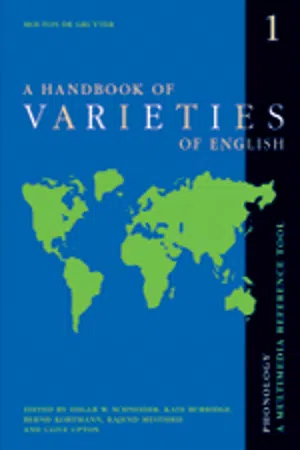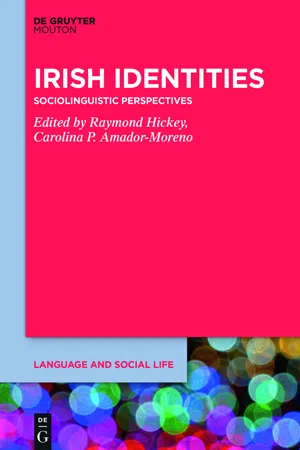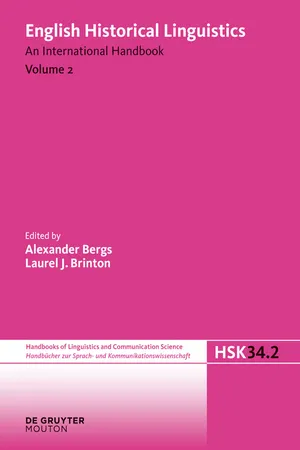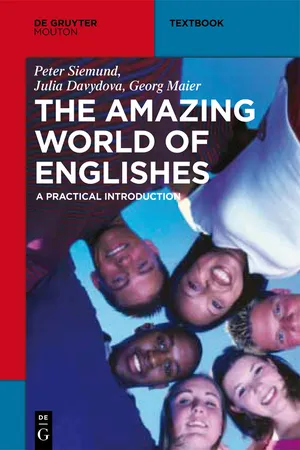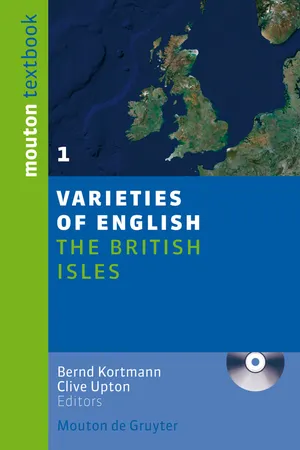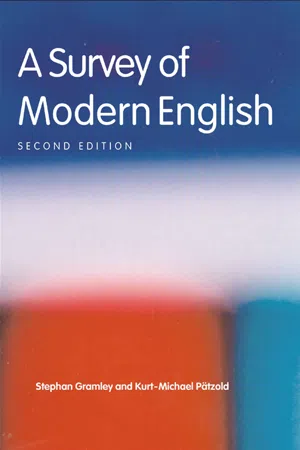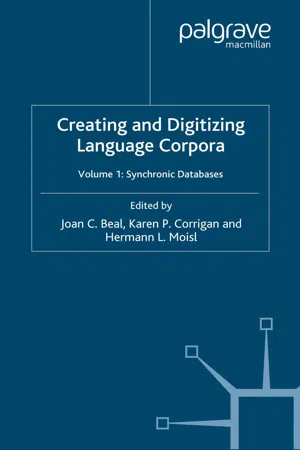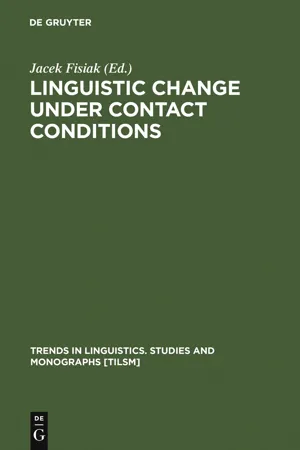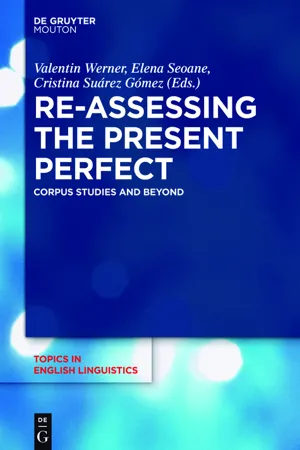Languages & Linguistics
Irish English
Irish English refers to the various dialects and forms of the English language spoken in Ireland. It is influenced by the Irish language and has distinct phonological, grammatical, and lexical features. Irish English reflects the historical and cultural influences on the language, and it continues to evolve as a unique variety of English.
Written by Perlego with AI-assistance
Related key terms
1 of 5
12 Key excerpts on "Irish English"
- eBook - PDF
A Handbook of Varieties of English
A Multimedia Reference Tool. Volume 1: Phonology. Volume 2: Morphology and Syntax
- Bernd Kortmann, Edgar W. Schneider(Authors)
- 2008(Publication Date)
- De Gruyter Mouton(Publisher)
However, not all authors share this opinion, see for example Dolan (1998) who uses the term Hiberno-English. Irish English is the simplest and most convenient term. It has the advantage that it is parallel to the designations for other varieties, e.g. American, Australian, Welsh English and can be further differentiated where necessary. Throughout the present chapter this term will be used. In the north of the country terms are used which reflect historical origins, e.g. Ulster Scots for the English stemming from the initial Lowland Scots settlers, Mid-Ulster English for geographically central varieties which are largely of northern English provenance. There is much discussion of the status of Ulster Scots as a possible separate language and similarly the status of Scots is debated. A discus-sion of this issue is, however, well beyond the brief of the current chapter. Irish English: phonology 69 Contact English is found occasionally to refer globally to varieties spoken in areas where Irish is also spoken (in Donegal, Connemara and Kerry, see maps at end of chapter). 1.1. Historical background The most cursory glance at the history of Irish English reveals that it is divided into two periods. The first period starts in the late 12 th century with the arrival of the first English-speaking settlers and finishes around 1600 when the second period opens. The main event which justifies this periodisation is the renewed and vigorous planting of English in Ireland at the beginning of the 17 th century. One must first understand that during the first period the Old English, as this group is called in the Irish context, came increasingly under the influence of the Irish. The Anglo-Normans who were the military leaders during the initial settlement had been completely absorbed by the Irish by the end of the 15 th century. The progres-sive Gaelicisation led the English to attempt planting the Irish countryside in order to reinforce the English presence there. - eBook - ePub
Irish Identities
Sociolinguistic Perspectives
- Raymond Hickey, Carolina P. Amador-Moreno, Raymond Hickey, Carolina P. Amador-Moreno(Authors)
- 2020(Publication Date)
- De Gruyter Mouton(Publisher)
For urban Irish English an additional social dimension arose (see contributions in Hickey ed., 2016) with vernacular varieties offering a unique profile for many city dialects such as those in Dublin (Hickey 2005) or Cork. The extent to which ethnicity is reflected in language differences was investigated for Derry by Kevin McCafferty some years ago (McCafferty 2001) and adds a further dimension to identity issues, one which is not present in the Republic of Ireland or only with the non-Irish born, the so-called New Irish or non-nationals (Diskin and Regan 2015). Linguistic identity manifests itself on different levels of language. For instance, on the phonetic level there are newly adopted features from American English (Hickey 2016) and, with these, young people in Ireland today have been developing new profiles for the sound system of Irish English. This is true on the grammatical level (Filppula 2012 ; van Hattum 2012 ; Ronan 2005 ; Siemund and Beal 2011) and not least on that of pragmatics where Irish English has a unique profile (Barron 2017) vis à vis other varieties of the English language and which it continues to maintain. The use of specific discourse markers (Amador-Moreno 2005, 2010 : 119–123; Vaughan and Clancy 2011; Murphy and Farr 2012) in colloquial speech and in fictional representations (Amador-Moreno 2016 ; Amador-Moreno and Terrazas-Calero 2017 ; Barron 2017), and indeed in translations (Cronin 2011), attest to the vitality of this key variety of English and the strong function it serves in contemporary Irish society as a carrier of identity for its speakers. It is hoped that the chapters in the present volume will contribute to an understanding of the dynamics of linguistic identity in today’s world (Evans ed., 2015) by highlighting aspects of the Irish context which are of general relevance, e.g. to post-colonial societies (Sandhu and Higgins 2016) of the anglophone world, or other regions of Britain (see McColl Millar 2010) - eBook - PDF
- Alexander Bergs, Laurel J. Brinton, Alexander Bergs, Laurel J. Brinton(Authors)
- 2012(Publication Date)
- De Gruyter Mouton(Publisher)
What we have ex-plored in this chapter is intended as a picture that is influenced by traditional dialect but which looks at developments in the standard of today: further work on Irish English and globalization, the rise of urban vernacular speech, dialectal convergence and diver-gence, and the role of other languages in the more multilingual Ireland of today remain for further study. 5 References Allsopp, Richard. 1980. How does the creole lexicon expand? In: Albert Valdman and Arnold High-field (eds.), Theoretical Orientations in Creole Language Studies , 89–107. London: Academic Press. Amador-Moreno, Carolina P. 2010. An Introduction to Irish English . London: Equinox. Beecher, Sea ´n. 1991. A Dictionary of Cork Slang . 2nd edn. Cork: Collins Press. Berry, Henry F. (ed.). 1907. Statutes and Ordinances, and Acts of the Parliament of Ireland. King John to Henry V . Dublin: Stationery Office. Bliss, Alan J. 1979. Spoken English in Ireland: 1600–1740: Twenty-Seven Representative Texts Assembled & Analysed . Dublin: Dolmen Press. Bradshaw, Brendan. 1979. The Irish Constitutional Revolution of the Sixteenth Century . Cam-bridge: Cambridge University Press. Braidwood, John. 1964. Ulster and Elizabethan English. In: George Brendan Adams (ed.), Ulster Dialects: An Introductory Symposium , 5–109. Cultra Manor: Ulster Folk Museum. Cahill, Edward. 1938. Norman French and English languages in Ireland. Irish Ecclesiastical Rec-ord 5th ser. 51: 159–173. Central Statistics Office. 2007. Census 2006: Vol . 9 : Irish Language . Dublin: Stationery Office. Clarke, Sandra. 1997. The role of Irish English in the formation of New World Englishes: the case of Newfoundland. In: Jeffrey L. Kallen (ed.), Focus on Ireland , 207–225. Amsterdam/Philadel-phia: John Benjamins. Corrigan, Karen P. 2010. Irish English, Vol. 1: Northern Ireland . Edinburgh: Edinburgh University Press. Crowley, Tony. 2005. Wars of Words: The Politics of Language in Ireland 1537–2004 . - eBook - PDF
The Amazing World of Englishes
A Practical Introduction
- Peter Siemund, Julia Davydova, Georg Maier(Authors)
- 2012(Publication Date)
- De Gruyter Mouton(Publisher)
Chapter 2 Irish English Inner circle 35 Irish English Introduction Irish English, also known as Hiberno- English, is one of the so-called Celtic Englishes, i.e. varieties of English spo-ken in the regions originally inhabited by the Celtic population. These areas in-clude Ireland, Scotland, the Isle of Man, and Cornwall. The variety of Irish English is the result of contact between English and Irish Gaelic, the history of which can be traced back to the 12th century, when the country was invaded by a joint force comprising Anglo-Normans, English, Welsh, and some Flemish (Hickey 2007: 30). English did not really gain ground at that time, though. Rather, the colonis-ers became proficient in two languages gradually shifting to Irish (Mesthrie and Bhatt 2008: 14). English, however, con-tinued to be spoken in the area around Dublin and its hinterland up until the 16th century. Vernaculars of English spoken in these parts of Ireland may even today still bear traces of the lan-guage associated with the first English settlement (Hickey 2007: 432). It was not until the beginning of the 17th century that English steadily began to gain ground throughout Ireland. The 19th century was marked by an increas-ing shift towards English and a con-comitant decline of Irish. Three events in particular account for these processes: The emancipation of the Catholic com-munity, the Great Famine of the late 1840s, and the emigration to the New World. The first event led to the estab -lishment of an educational system in which instruction took place in English. The Great Famine decimated the Irish-speaking population, which died from starvation, and caused massive poverty in Ireland. Those who could afford to left Ireland for North America and Aus-tralia. English thus was adopted as a second language by large parts of the popula-tion. Many people did not learn English at school but acquired it spontaneously from native speakers or more proficient peers. - eBook - PDF
- Bernd Kortmann, Clive Upton, Bernd Kortmann, Clive Upton(Authors)
- 2008(Publication Date)
- De Gruyter Mouton(Publisher)
However, not all authors share this opinion, see for example Dolan (1998) who uses the term Hiberno-English. Irish English is the simplest and most convenient term. It has the advan-tage that it is parallel to the designations for other varieties, e.g. American, Australian, Welsh English and can be further differentiated where necessary. Throughout the present chapter this term will be used. In the north of the country terms are used which reflect historical origins, e.g. Ulster Scots for the English stemming from the initial Lowland Scots settlers, Mid-Ulster English for geographically central varieties which are largely of 72 Raymond Hickey northern English provenance. There is much discussion of the status of Ul-ster Scots as a possible separate language and similarly the status of Scots is debated. A discussion of this issue is, however, well beyond the brief of the current chapter. Contact English is found occasionally to refer globally to varieties spoken in areas where Irish is also spoken (in Donegal, Connemara and Kerry, see maps at end of chapter). 1.1. Historical background The most cursory glance at the history of Irish English reveals that it is divided into two periods. The first period starts in the late 12 th century with the arrival of the first English-speaking settlers and finishes around 1600 when the second period opens. The main event which justifies this periodisation is the renewed and vigorous planting of English in Ireland at the beginning of the 17 th century. One must first understand that during the first period the Old English, as this group is called in the Irish context, came increasingly under the influence of the Irish. The Anglo-Normans who were the military leaders during the initial settlement had been completely absorbed by the Irish by the end of the 15 th century. The progressive Gaelicisation led the English to attempt planting the Irish countryside in order to reinforce the English presence there. - Jeffrey L. Kallen(Author)
- 2013(Publication Date)
- De Gruyter Mouton(Publisher)
Between 1910 and 2012, then, we have no more than a handful of book-length treatments of Irish English as a whole: see Corrigan (2010), of course, for a review of parallel and complementary research pertaining to Northern Ireland. Reflec-tive essays which try to develop an academic field focused on Irish English have also been few. Vendryes (1958–59: 216) took the opportunity in reviewing Henry’s (1957) work to argue against the excessive use of terms such as (in French) “sub-strat”, “superstrat”, and “adstrat”, arguing instead that the essential facts of bilingualism lie not in such strata, but in the mind and the will of the speaker. In a comment which anticipates more sociolinguistic approaches, Vendryes also called for dialectal description to delineate precisely where, by whom, and for what purpose the language being described is used. Though this call went largely unheeded in favour of the substrate versus superstrate origins debate, later work in sociolinguistics, discourse analysis, and corpus linguistics resonates with this early critique. In Kallen ([1981] 1985), I sought to advance a “global view” of Irish English, using “global” both in a geographical sense to compare Irish English not only to English as found elsewhere, but to other cases of language contact (including creole varieties and stable bilingualism), and in a grammatical sense to refer to grammatical rules at all linguistic levels as well as areas such as lan-guage acquisition and second language learning which did not fall within the remit of linguistic theory at the time. The paper was intended as an argument for an expanded perspective on Irish English, partly as a reaction to the narrowness of evidence used in the origins debate. The origins debate itself has been largely developed within the major volumes mentioned thus far, or within papers devoted to specific topics (espe-cially syntax), which will be discussed below.- eBook - ePub
- Stephan E Gramley, Michael Pátzold(Authors)
- 2004(Publication Date)
- Routledge(Publisher)
Gaeltacht, Irish is still spoken; and Irish is the Republic’s official language (together with English, the second official language). The percentage of population who actually speak Irish is, however, very low (around two per cent).10.3.1 Northern Ireland
The split in Ireland as a whole is reflected once again within the historical province of Ulster, which is partly in the Republic (the three counties of Cavan, Donegal and Monaghan) and partly in Northern Ireland. The population of Northern Ireland itself is divided very much along confessional lines, somewhat under one half Roman Catholic (the Republic is over 90 per cent Catholic) and the remainder chiefly Protestant. This, too, reflects the historical movement of people to and within Ireland. The northern and eastern parts of the province are heavily Scots and Protestant; the variety of English spoken there is usually referred to as Ulster Scots or, sometimes, Scotch-Irish. Further to the south and west the form of English is called Mid-Ulster English, and its features increasingly resemble those of English in the South, with South Ulster English as a transitional accent.The same split, but also new, mixed or compromise forms, can be observed in Belfast, which at approximately half a million is the largest city in Northern Ireland and second only to Dublin in all of Ireland. Although there is a great and ever growing amount of sectarian residential patterning, speech forms in the city as a whole are said to be merging (Barry 1984: 120). Harris, for example, states: ‘The vowel phonology of Mid Ulster English can be viewed as an accommodation of both Ulster Scots and south Ulster English systems’ (1984: 125). Phonetically, however, there are distinct Ulster Scots and South Ulster English allophones in Belfast. One of the most potent reasons advanced for the increasing levelling of speech forms is the weakening of complex (’multiplex’) - eBook - PDF
Creating and Digitizing Language Corpora
Volume 1: Synchronic Databases
- J. Beal, K. Corrigan, H. Moisl, J. Beal, K. Corrigan, H. Moisl(Authors)
- 2007(Publication Date)
- Palgrave Macmillan(Publisher)
Language Links: The Languages of Scotland and Ireland, ed. by J. M. Kirk. and D. P. Ó Baoill, pp. 23–42. Belfast: Cló Ollscoil na Banríona. Filppula, M. 2004. ‘Irish English: morphology and syntax’. A Handbook of Varieties of English, Volume 2, ed. by B. Kortmann, K. Burridge, R. Mesthrie, E. W. Schneider and C. Upton, pp. 73–101. Berlin: Mouton de Gruyter. Görlach, M. 1995. ‘Irish English and Irish culture in dictionaries of English’. More Englishes, ed. by M. Görlach, pp. 164–91. Amsterdam: Benjamins. Görlach, M. 2002. A Textual History of Scots. Heidelberg: Universitätsverlag C. Winter. Greenbaum, S. 1988. ‘A proposal for an International Corpus of English’. World Englishes 7:315. Greenbaum, S. (ed.). 1996a. Comparing English Worldwide: The International Corpus of English. Oxford: Clarendon Press. Greenbaum, S. 1996b. ‘Introducing ICE’. Comparing English Worldwide: The International Corpus of English, ed. by S. Greenbaum, pp. 3–12. Oxford: Clarendon Press. Greenbaum, S., G. Nelson and M. Weitzman. 1996. ‘Complement clauses in English’. Using Corpora for Language Research, ed. by J. Thomas and M. Short, pp. 76–91. London: Longman. Gregg, R. J. 1972. ‘The Scotch–Irish dialect boundaries in Ulster’. Patterns in the Folk Speech of the British Isles, ed. by M. F. Wakelin, pp. 109–39. London: Athlone Press. ICE-Ireland: Local Variations on Global Standards 157 Harris, J. 1983. ‘The Hiberno-English “I’ve it eaten” construction: what is it and where does it come from?’ Teanga 3:30–43. (Reprinted in Ó Baoill, D. P. (ed.) 1985. Papers on Irish English. Dublin: Irish Association for Applied Linguistics.) Harris, J. 1984. ‘Syntactic variation and dialect divergence’. Journal of Linguistics 20:303–27. Harris, J. 1985. The Polylectal Grammar Stops Here. CLCS Occasional Paper, 13. Dublin: Centre for Language and Communication Studies, University of Dublin, Trinity College. - eBook - PDF
- Jacek Fisiak(Author)
- 2010(Publication Date)
- De Gruyter Mouton(Publisher)
However, for the assessment of the role of contact in the development of Irish English a corpus-based approach could only take written documents as its material. These are not available in any satisfac-tory quantity throughout the history of Irish English. Authors who have used Irish English as a medium for artistic expression, like Synge and O'Casey (in their different ways) have engaged in much too much poetic license for their works to be of statistical value and these are of far too late a date for them to be used when investigating the genesis of features of Irish English syntax. 112 Raymond Hickey 2. A sketch of Irish English The beginnings of Irish English cannot be given an historical date.' In-stead one refers to the coming of the English to Ireland in 1169 (Moody— Martin 1967: 127—134) and the ensuing years as marking the beginning of English influence in Ireland. At this early stage the linguistic situation of the country was much more diversified than at present. Firstly, both Anglo-Norman and English were introduced into Ireland and co-existed side by side for at least two centuries; see Curtis (1919: 234). This is apparent from many historical documents, most of all in the famous Statutes of Kilkenny issued in 1366 which, while written in Nor-man French, admonish the native Irish to speak English (Lydon 1973: 94 ff.). Secondly, the dominance of English over Irish is by no means a con-tinuous progression, driving back the native Celtic language to the Atlan-tic coast. English was subject to various vicissitudes in the early period of the colonization of Ireland. Indeed it only survives without a break in Dublin and perhaps in a few other cities of the East coast such as Wex-ford and Waterford. During the four centuries from the initial invasions to the military defeat of the Irish by English forces in the Battle of Kinsale in 1601, English lost ground continuously as a consequence of Gaelic resurgence. - eBook - PDF
- Valentin Werner, Elena Seoane, Cristina Suárez-Gómez, Valentin Werner, Elena Seoane, Cristina Suárez-Gómez(Authors)
- 2016(Publication Date)
- De Gruyter Mouton(Publisher)
Additional factors must be considered, as he notes, and one such is national identity. I would like to add to this the role of the national language(s): whether dominant or receding or even lost under the pressure of another lan-guage, they may continue to play a role as a substrate language. In the case at hand and in the light of the evidence from IrE and HebE, it is clear that geograph-ical proximity has been overridden by continuing influence from the substrate Celtic languages and their tense and aspect systems. Acknowledgements This research and the writing of this article were supported by the Academy of Finland funding for the research consortium entitled “Changing English: users and learners worldwide” (grant no. 269385), which I gratefully acknowledge. I would like to thank Cathlin Macaulay and Caroline Milligan of the School of Scottish Studies, University of Edinburgh, for making it possible for me to gain access and use the Hebridean English audio recordings and transcripts. I am also grateful to two anonymous reviewers whose comments and suggested corrections have been very helpful. Of course, any possible errors or other shortcomings will remain my own responsibility. References: Banim, John. 1992 [1826]. The Nowlans . Belfast: Appletree Press. Bauer, Gero. 1970. The English ‘perfect’ reconsidered. Journal of Linguistics 6. 189–198. Bliss, Alan J. 1977. The emergence of modern English dialects in Ireland. In Diarmaid Ó Muirithe (ed.), The English language in Ireland , 7–19. Dublin: The Mercier Press. Bliss, Alan J. 1979. Spoken English in Ireland, 1600 – 1740 . Dublin: The Dolmen Press. Brinton, Laurel J. 1988. The development of English aspectual systems. Cambridge: Cambridge University Press. Clarke, Sandra. 1997. The role of Irish English in the formation of new World Englishes: The case from Newfoundland. In Jeffrey L. Kallen (ed.), Focus on Ireland , 207–225. Amsterdam: Benjamins. Clement, David. 1997. Highland English. - eBook - PDF
- R. Hickey(Author)
- 2016(Publication Date)
- Palgrave Macmillan(Publisher)
If the latter is true, then enregisterment could become a trigger for language change, i.e. spuriously enregistered features, like ort for art, could lead to a genuine instance of language change if speakers begin to use the ort pronunciation outside the context of enregisterment. 1.9 Conclusion The development of the English language in Ireland, both historically and at the present, has provided food for linguistic discussion and con- tinues to do so, due to the long-term interaction of Irish and English and to different types of regional input. General linguistic insights into language contact and language shift have recently been brought to bear on research into English in Ireland. There has also been an increasing awareness of the different varieties represented historically in Ireland and surviving to this day, e.g. Ulster Scots (Hickey 2011a). It is a measure of the maturity of the field that all subareas have been covered by significant publications of late; cf. the attention given to the pragmatics of Irish English in recent publications (Barron and Schneider (eds) 2005; Amador-Moreno et al. (eds) 2015) and to the arguments for various standpoints, especially the relative weight accorded to contact Raymond Hickey 35 versus retention (Filppula 1999, 2003) in the historical development of Irish English. The databases for analyses have also been expanded through the compilation of a number of text corpora documenting Irish English in several respects (Kirk and Kallen 2008; Hickey 2003a). Avenues which remain to be fully explored do exist, most noticeably contemporary urban Irish English and non-native varieties used by immigrants (Diskin and Regan 2015), the most likely loci of linguistic change in years to come. Note 1. Audio examples of Short Front Vowel Lowering can be found on the research website Variation and Change in Dublin English accessible at the following URL: http://www.uni-due.de/VCDE. - eBook - ePub
The Grammar of Irish English
Language in Hibernian Style
- Markku Filppula(Author)
- 2002(Publication Date)
- Routledge(Publisher)
Although especially the first of the three points listed by Hayden and Hartog focuses on lexicon rather than grammar, they nevertheless define the agenda for subsequent research on HE grammar as a whole. What the authors discuss under the heading of ‘solecisms’ could in modern terms be described as transfer phenomena typically arising in a second-language acquisition (SLA) situation. Writing at about the same time—and probably independently of Hayden and Hartog—Joyce (1910/1988:1) arrives at a very similar characterisation of HE: according to him, ‘Anglo-Irish dialectical words and phrases’ derive from three main sources, which are the Irish language, ‘Old English’ and the dialect of Scotland, and independent developments within the dialects of English spoken in Ireland. ‘Old English’ refers here to both the medieval varieties introduced into Ireland from the time of the Anglo-Norman invasion and the later varieties spoken by the Elizabethan planters (Joyce 1910/1988:6–7). The views expounded by Hayden and Hartog (1909) and Joyce (1910/1988) are closely echoed by another contemporary scholar, van Hamel (1912), who also singles out earlier stages of English as a major contributory source to ‘Anglo-Irish’ vocabulary, in particular, whereas the influence of Irish is best in evidence in ‘those strange syntactical constructions which make Anglo-Irish an almost incomprehensible language to anybody not knowing Gaelic’ (van Hamel 1912:274).Apart from some differences in points of emphasis, decades of research since the early twentieth-century pioneers have not changed the overall portrayal of HE grammar. Thus, Bliss concludes his description of southern HE as follows:In the pronunciation and vocabulary of southern Hiberno-English it is possible to trace the influence both of older strata of the English language and of the Irish language; in grammar, syntax and idiom the peculiarities of southern Hiberno-English depend exclusively on the Irish language. Even in the parts of Ireland where Irish has long been extinct its unconscious influence still controls the usage of speakers of English.(Bliss 1984a:150)More recently, Harris (1993:140), in reference to the popular view according to which HE is ‘a mixture of the language of Shakespeare and the Irish of the Gaelic earls’, remarks that it does indeed reflect the two main historical inputs to what he terms Modern Irish English. In comparison with Bliss, though, Harris places greater emphasis on the input from Early Modern English (EModE) and Scots especially in those areas where Irish has ceased to be spoken long ago and where the English and Scots settlements have had a stronger impact on the dialect (see, e.g. Harris 1993:141). Kallen (1986) is another researcher who draws attention to the retention of earlier English features especially in the verbal aspect systems of HE grammar.
Index pages curate the most relevant extracts from our library of academic textbooks. They’ve been created using an in-house natural language model (NLM), each adding context and meaning to key research topics.
